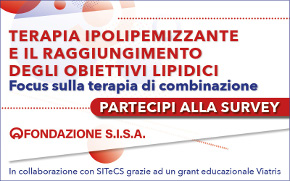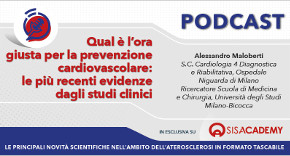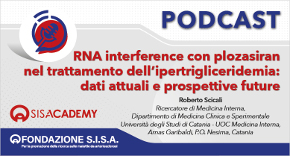 Rivista in lingua italiana
Rivista in lingua italiana
riservata ai Soci SISA
Ultimo numero:
Anno 16 • N.1/2025
SISANews
Il rischio del fumo nei pazienti in terapia con statine
Il fumo, si sa, determina vari effetti dannosi sul sistema cardiovascolare ed alcuni di questi sono controbilanciati dalle statine. Per esempio il fumo altera la funzione endoteliale e le statine la migliorano, il fumo favorisce la formazione del trombo piastrinico e le statine hanno invece proprietà antitrombotiche, il fumo riduce le HDL e le statine tendono ad innalzarle. Ci si dovrebbe attendere che la terapia con statine quantomeno attenui gli effetti avversi del fumo. Invece il fumo conserva un effetto negativo sulla morbilità e mortalità cardiovascolare anche in coloro che sono cronicamente trattati con statine. E' quanto emerge da questa analisi basata sui dati di due ben noti studi di intervento, il TNT e l'IDEAL che confermano che chi continua a fumare, a parità di trattamento con statine, ha un rischio di nuovi eventi significativamente più elevato di chi ha smesso.
![]()
Impact of smoking on cardiovascular events in patients with coronary disease receiving contemporary medical therapy (from the Treating to New Targets [TNT] and the Incremental Decrease in End Points Through Aggressive Lipid Lowering [IDEAL] trials)
Frey P, Waters DD, DeMicco DA, Breazna A, Samuels L, Pipe A, Wun CC, Benowitz NL.
Am J Cardiol 2011;107:145-50
To define the incremental risk of cigarette smoking in patients with coronary disease receiving contemporary medical therapy, we performed a post hoc analysis of 18,885 patients by combining data from the Treating to New Targets (TNT) and the Incremental Decrease in End Points through Aggressive Lipid Lowering (IDEAL) trials. These studies compared high-dose treatment (atorvastatin 80 mg/day) to moderate-dose treatment (atorvastatin 10 mg/day in TNT and simvastatin 20 to 40 mg/day in IDEAL) in patients with established coronary heart disease. The primary end point of this pooled analysis was major cardiovascular events, a composite of cardiac death, myocardial infarction, stroke, or resuscitated cardiac arrest. At baseline 4,196 patients had never smoked, 11,513 were ex-smokers, and 3,176 were current smokers. The adjusted hazard ratio for current smokers compared to never smokers was 1.68 (95% confidence interval 1.46 to 1.94) and that for current smokers compared to ex-smokers was 1.57 (95% confidence interval 1.41 to 1.76). Event rates for current smokers compared to ex-smokers were similarly increased in each treatment group. The difference in absolute event rates between current and ex-smokers in this pooled analysis was 4.5%, which is >2 times as large as the decrease in absolute event rates between high-dose and moderate-dose statin therapy found in the IDEAL (1.7%) and TNT (2.2%) trials, respectively. In conclusion, in patients with coronary disease receiving modern medical therapy, smoking cessation is of substantial benefit with a number needed to treat of 22 to prevent a major cardiovascular event over 5 years. Smoking cessation deserves greater emphasis in secondary prevention.

Area Soci
Eventi
39° Congresso Nazionale
 39° Congresso Nazionale
39° Congresso NazionaleRoma, 23-25 novembre 2025
Save the date




 Spring Meeting Gruppi Giovani SID, SIGG, SIIA, SIMI, SIPREC, SISA
Spring Meeting Gruppi Giovani SID, SIGG, SIIA, SIMI, SIPREC, SISARimini, 6-8 aprile 2025
[continua a leggere]
 SISA LIPID ACADEMY - Corso avanzato di lipidologia clinica
SISA LIPID ACADEMY - Corso avanzato di lipidologia clinicaModena, 4-5 Luglio 2024
[continua a leggere]Giornale Italiano Arteriosclerosi
HoFH today
 Rivista Italiana della
Rivista Italiana della
Ipercolesterolemia
Familiare Omozigote
Anno 6 • N.1/2024
Rivista NMCD
Diateca
[continua a leggere]
[continua a leggere]
Newsletter
il vostro indirizzo di posta elettronica
Progetto LIPIGEN

Nuovo sito dedicato al Progetto LIPIGEN
Progetto LIPIGEN - Vecchio portale
E' necessario essere loggati come utente
Lipigen per poter accedere alla pagina
PROject Statin Intolerance SISA
PROSISA – PROject Statin Intolerance SISA
E' necessario essere loggati come utente
PROSISA per poter accedere alla pagina
GILA - Lipoprotein Aferesi
Gruppo Interdisciplinare Lipoprotein Aferesi
(Accesso Gruppo GILA-Lipoprotein Aferesi)
E' necessario essere loggati come utente del Gruppo GILA per poter accedere
Gruppo Interdisciplinare Lipoprotein Aferesi
(Documentazione ad accesso libero)
Pagina informativa per medici e pazienti










